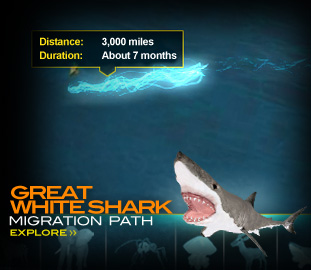Great White Shark
Animals — Great White Shark
INTERACTIVE GREAT WHITE SHARK PROFILE
GREAT WHITE SHARK (Carcharodon carcharias)
Great whites are the only member of the genus Carcharodon. They are members of the family Lamnidae, which also includes mackerel sharks and porbeagles. No one knows how many of these magnificent predators exist, but indications are that individuals may roam vast swaths of the oceans. One female great white tracked by scientists covered 12,400 miles in a single nine-month period. Great whites eat a variety of creatures, including sea lions, elephant seals, small toothed whales, fish, rays, sea turtles and sea otters. They also have been known to attack humans, but probably by mistake, and do not eat them. The great white’s only natural enemy is the killer whale, one of the few animals capable of preying upon them. Fishermen, who prize them as a trophy fish, are a bigger threat.
For years, little was known about great whites’ migration patterns, because the deep swimming creatures were difficult to observe and track. It was thought that they stayed fairly close to the shoreline, where they could most easily find sea lions and other prey. In recent years, however, scientists have used satellites and radio-tagging to investigate the sharks’ movements. What they have found so far is nothing short of astonishing. Great whites may well be the planet’s most extensive travelers, roaming many thousands of miles each year. In one study of 24 white sharks, researchers identified at least three different migration patterns, including wide-ranging coastal trips up and down the eastern side of South Africa. One shark crossed the Indian and Pacific oceans and back. Why they travel so far is not yet completely understood.
Great whites’ most important role in the ocean ecosystem is to help control the population growth of species that they prey upon. They also are hosts to parasites such as copepods.
MORE MIGRATIONS
-
Preserve their HabitatHelp conserve the natural landscapes of these migratory species.
-
Teacher ResourcesJoin the virtual assembly and access lesson plans specific to your area.
-
Nat Geo ExpeditionsTake a migration of your own with National Geographic Explorers.
-
Science Behind MigrationsHow do animals decide where to go, how long to stay, and when to leave?













